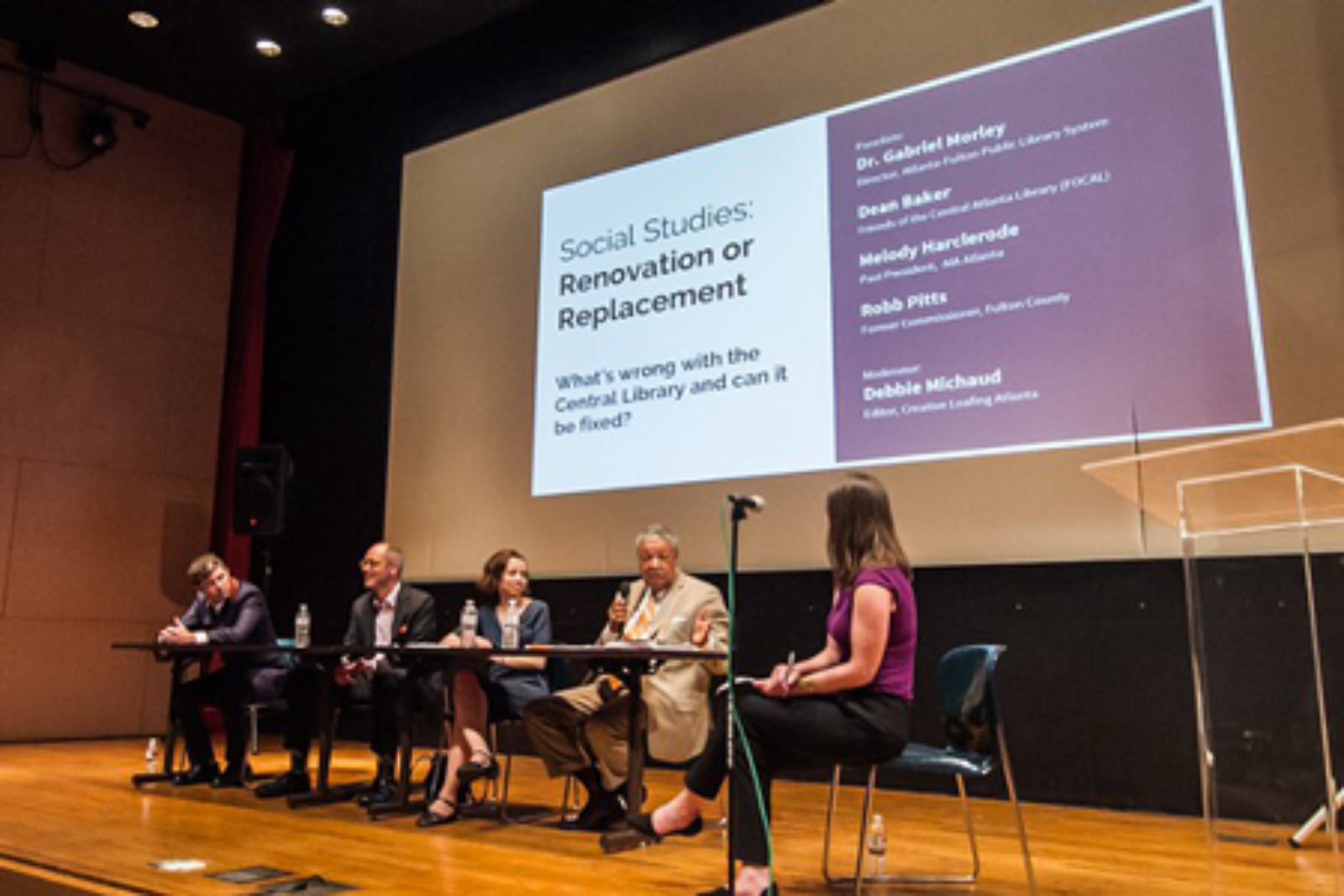 By °®¶¹app/Georgia
By °®¶¹app/Georgia
For several years members of the Atlanta/Fulton County Library Authority, the agency responsible for area library service, have proposed abandoning its Central Library, Marcel Breuer’s last built project before his death, for a new “iconic” library. The structure is similar in character to the recently restored and adapted , the former Whitney Museum in Manhattan. The stated justification for this proposal is one part criticism of Brutalist architecture and one part failure to maintain the relevancy of the library system in a time when the primacy of the printed book is being called in to question by a plethora of digital offerings.
Panel discussion on the future of the library. Credit:
When the Central Library opened in 1980, it was cutting edge in its architecture and the services it offered. But decades of shrinking budgets and understaffing has resulted in an outdated and poorly-maintained library. A Master Plan prepared for the library authority in 2008 recognized this and initially recommended renovations to the facility to bring it up to 21st-century library standards. However, a late revision to the master plan suggested that a new “iconic” Central Library building would be a better use of public funds than adapting the Breuer to meet future needs. A 275 million dollar bond referendum was approved following the master plan, with a majority of the funds earmarked for branch libraries. Now, months away from the deadline to issue the second phase of bond funds, the library board and the Fulton County Board of Commissioners, are debating how to spend the funds designated for the Central Library; abandon the Breuer building or renovate it.
The irony to all of this, of course, is that the “iconic” Breuer Library replaced an earlier ‘iconic’ library, the 1902 Carnegie Library, which was torn down in 1977.

(Left) 1902 Carnegie Library. Credit: The Library of Congress. (Right) Current library designed by Breuer and opened in 1980.
When news of the threat to the Central Library initially surfaced in 2008, a coalition of design and preservation groups, led by the Georgia Chapter of °®¶¹app, including public lectures and mounting of an internationally recognized exhibit on Breuer, utilizing the Central Library Building as the venue. The structure was included in the World Monuments Fund of endangered significant buildings in 2010.
In April of this year, talk of using the bond funds to buy land and build a new, smaller library building surfaced. And once again, advocacy efforts are in full swing to ensure that the Breuer building is saved preferably for continued use as a community educational and service resource. The Georgia Chapter of °®¶¹app members Scott Morris and Kyle Kessler have each been leading efforts to call attention to the current and ongoing discussion and debate and to coalesce support for the preservation and reuse of the building. Morris, along with several other °®¶¹appUS/Georgia members, has been working on increasing awareness of the building’s architectural significance and preparing a nomination to the National Register of Historic Places, while Kessler, through the Center for Civic Innovation, organized a panel discussion on the future of the library and is spearheading a social media campaign through the Friends of the Central Atlanta Library (FOCAL) group.

On May 18, 2016, the Fulton County Board of Commissioners met to vote of the fate of the Breuer Library, but decided to delay their decision awaiting further study and a public hearing. It was clear that the advocacy efforts to save the building have been productive and expressed support for the building heard – several commissioners noted that they had received emails and phone calls in support of renovating the existing building. Though the commissioners found it challenging to commit to a plan, they acknowledged that the fiscally-responsible, culturally-appropriate, and politically-prudent choice is the one that keeps the building and updates it to modern standards.
But this is Atlanta and tearing down buildings of architectural significance, even in the face of public outcry, is at risk of becoming part of our city’s identity. °®¶¹app/Georgia is actively engaged in the continued advocacy efforts and urges those that respect the building as a significant part of the history and fabric of the city to visit the building to experience what an architectural gem it is and join the advocacy efforts for its proper preservation and adaptation to meet the library, information and related service needs of the Atlanta-Fulton County Community well into the future.
Read More
